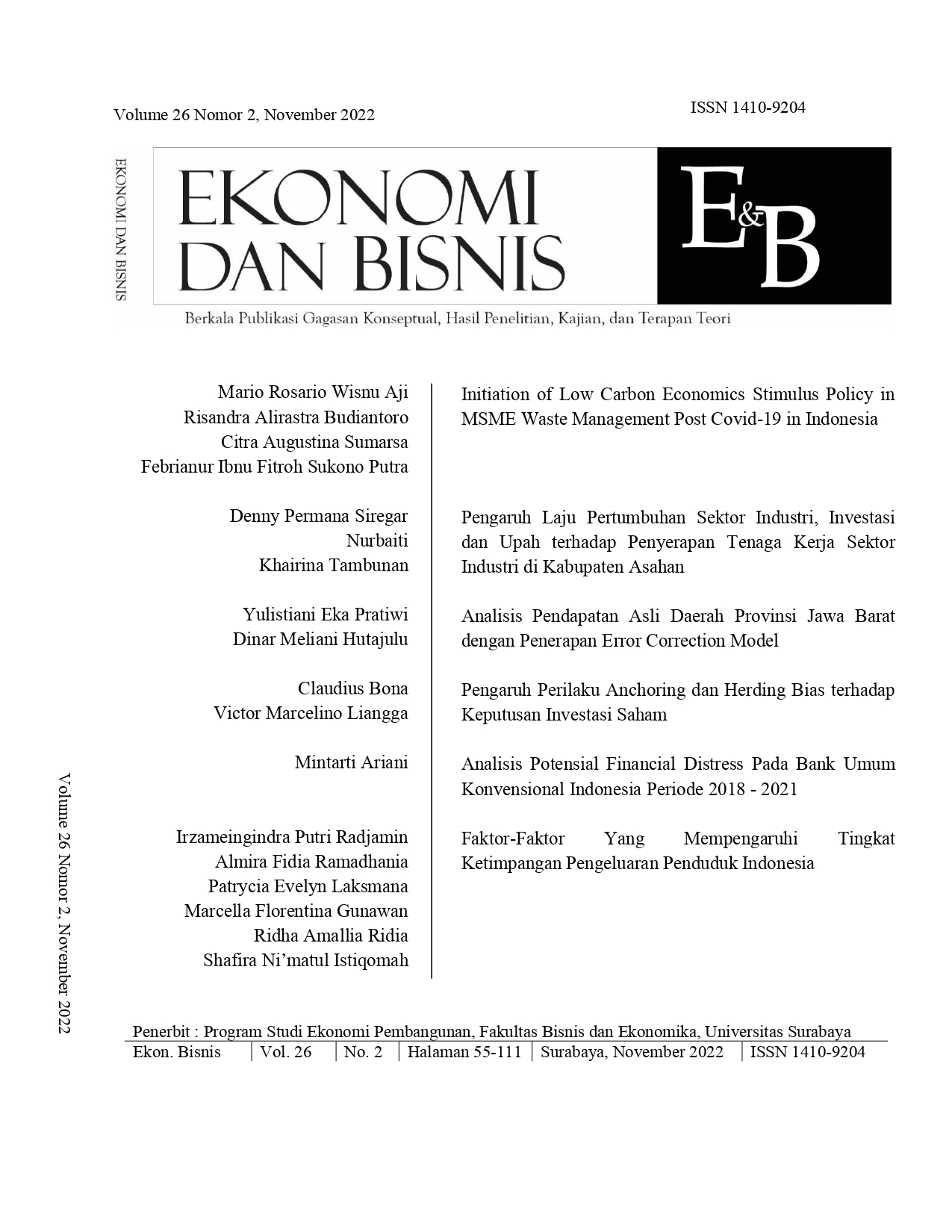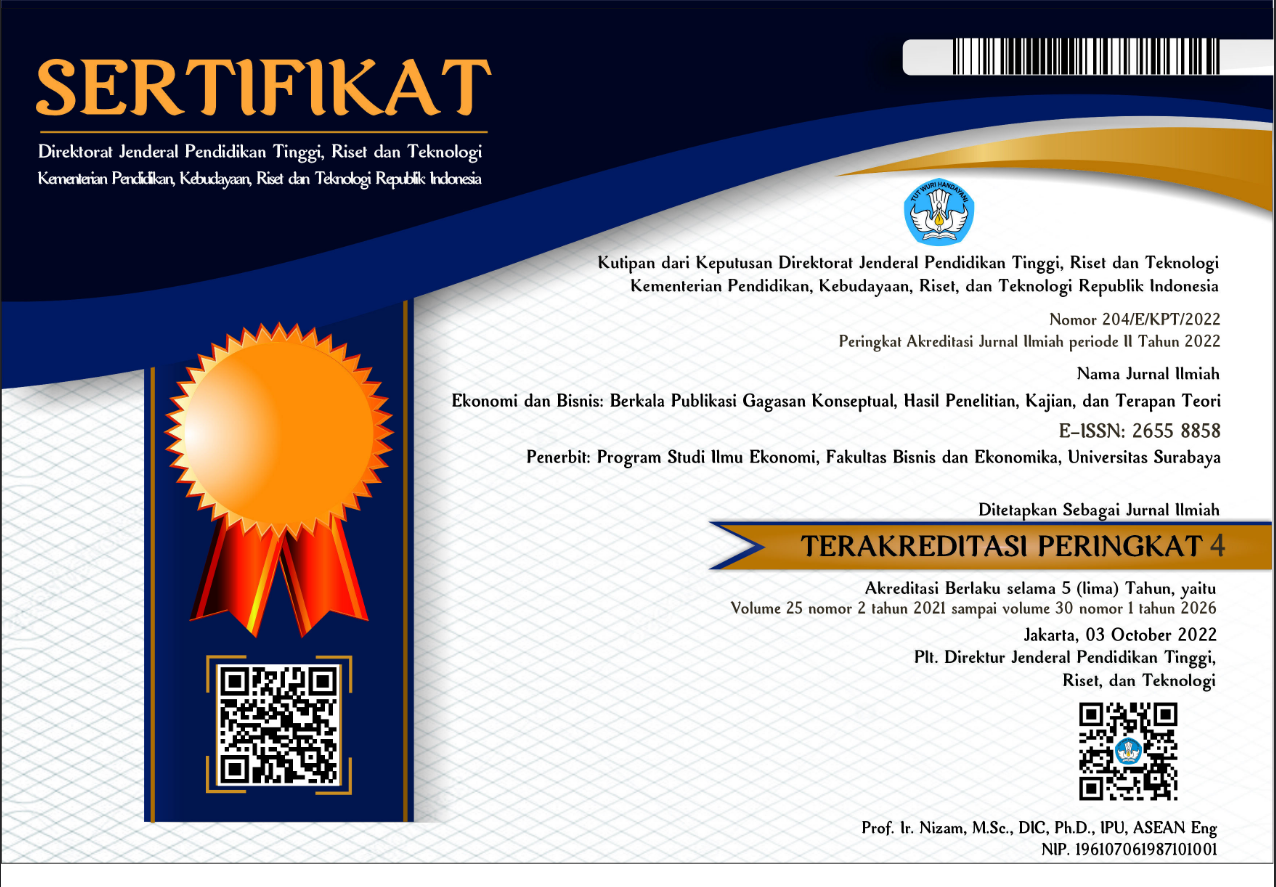PENGARUH PERILAKU ANCHORING DAN HERDING BIAS TERHADAP KEPUTUSAN INVESTASI SAHAM
Studi di Mahasiswa FBE Universitas Surabaya Semester 5 dan 7 Tahun 2022/2023
 Abstract Views:
673 times
Abstract Views:
673 times
 PDF (Bahasa Indonesia) Downloads:
678 times
PDF (Bahasa Indonesia) Downloads:
678 times
Abstract
Making an investment decision in the industrial revolution 4.0 is now a trend, especially in Indonesia. From KSEI's data in September 2022, there has been a 2.5-times increase in stock investment since the beginning of the pandemic in 2020. The significant increase in the number of stock investors, especially in students community during the pandemic has become an interesting factor to discuss. The influence of biased aspect of financial behavior in investing is often neglected by investors so they make an investment decision that are less than optimal. This study aims to determine the problems of investors' financial behavior aspects, especially anchoring behavior and herding bias related to stock investment decisions. Questionnaires are used as a tool to reveal respondents' opinions. Target respondents are students of the 5th and 7th semesters of the Faculty of Business and Economics, University of Surabaya. The data is then processed using SPSS 24 software. From the processing, research results’ show that anchoring bias has a positive and significant effect on investors' investment decisions. Moreover, for herding bias shows an insignificant effect for investment decisions. For future research, it is possible to examine the influence of other financial behaviors such as overconfidence and disposition effects on investment decisions among students.
Downloads
References
Badri, R. E., & Putri, M. E. (2021). Analisis Pengaruh Anchoring Bias dan Loss Aversion Dalam Pengambilan Keputusan Investasi Di Kota Bandar Lampung. Jurnal Bisnis Darmajaya, 7(1), 39–51.
Farooq, A., & Sajid, M. (n.d.). Factors Affecting Investment Decision Making: Evidence from Equity Fund Managers and Individual Investors in Pakistan.
Febri, W., & Lantara, I. W. N. (2020). Pengaruh Heuristic Biases Terhadap Pengambilan Keputusan Investasi (Studi Pada Investor Saham di Bursa Efek Indonesia) [Doctoral Dissertation]. Universitas Gadjah Mada.
Ghozali, I. (2018). Aplikasi Analisis Multivariate Dengan Program IBM SPSS 25 (9th ed.). Universitas Diponegoro.
Gleason, K. C., Mathur, I., & Peterson, M. A. (2004). Analysis of intraday herding behavior among the sector ETFs. Journal of Empirical Finance, 11(5), 681–694.
KSEI. (2022). Statistik Pasar Modal Indonesia.
Madaan, G., & Singh, S. (2019). An Analysis of Behavioral Biases in Investment Decision-Making. International Journal of Financial Research, 10(4), 55–67.
Mahanthe, S. (2018). JWSMD, dan Sugathadasa, D.(2018). The Impact of Behavioural Factors on Investment Decision Making in Colombo Stock Exchange. The International Journal of Business and Management, 6(8), 199–207.
Pranyoto, E., Susanti, S., & Septiyani, S. (2020). Herding behavior, experienced regret dan keputusan investasi pada bitcoin. Jurnal Bisnis Darmajaya, 6(1), 29–43.
Qasim, M., Hussain, R., Mehboob, I., & Arshad, M. (2019). Impact of herding behavior and overconfidence bias on investors’ decision-making in Pakistan. Accounting, 5(2), 81–90.
Setiawan, Y. C., Atahau, A. D. R., & Robiyanto, R. (2018). Cognitive dissonance bias, overconfidence bias dan herding bias dalam pengambilan keputusan investasi saham. AFRE (Accounting and Financial Review), 1(1).
Sugiyono. (2016). Metode Penelitian Kuantitatif dan Kualitatif dan R&D. IKAPI.
Tversky, A., & Kahneman, D. (1974). Judgment under Uncertainty: Heuristics and Biases: Biases in judgments reveal some heuristics of thinking under uncertainty. Science, 185(4157), 1124–1131.
Yu, H., Dan, M., Ma, Q., & Jin, J. (2018). They all do it, will you? Event-related potential evidence of herding behavior in online peer-to-peer lending. Neuroscience Letters, 681, 1–5.

 DOI:
DOI:















